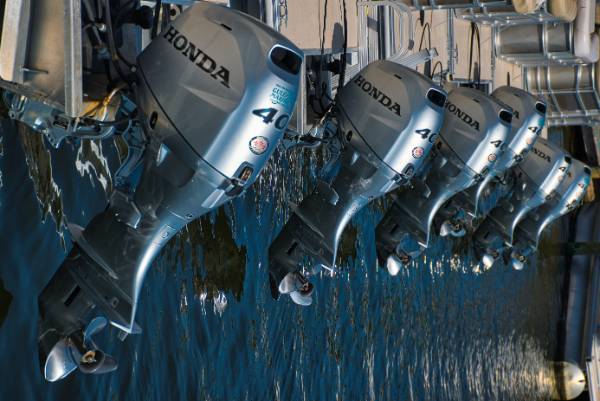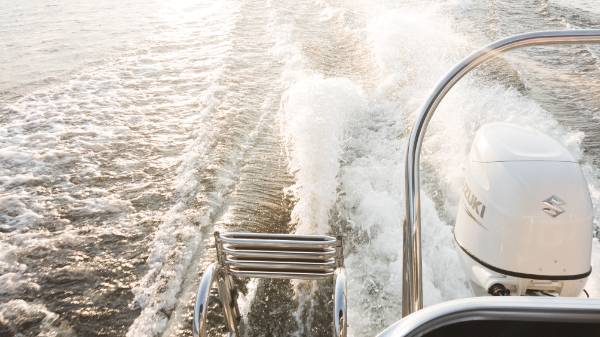Even though sailing in salt water is a highly sought-after experience, taking your boat out on the sea or ocean can seriously harm your boat’s structural integrity and longevity. If neglected, the cooling system in your marine engine can quickly become clogged with salt deposits and lead to serious damage. In this article, you can learn how to clean a boat engine correctly after salt water and how to protect your boat engine.
How To Clean Boat Engine After Salt Water
Choose The Right Boat Engine Cleaning Materials
To properly clean a boat engine after saltwater use, the right cleaning supplies must be located. More than you might realize, the effectiveness of the process can be affected by selecting the right boat soap and brush because it can be difficult to find durable materials that are also non-corrosive or too strong.
For instance, if you’re picking out a cleaning brush, I’d advise choosing one with softer bristles rather than one with firmer ones because doing so reduces the chance of scratching and marking the outside of your engine.
Choose an alternative that offers a soft-medium scrub instead because you still need to make sure the tool is powerful enough to remove any residue.
A soft microfiber cloth would be ideal to buy as well because it would make the process go more smoothly. In an effort to remove any remaining detergent or debris, clean the engine one last time with this softer cloth.
In relation to detergents, it’s important to look for a solution that’s made especially for cleaning boat engines.
Otherwise, there’s a chance you’ll end up with a product that’s either too harsh or too gentle, which could seriously compromise an engine’s performance and longevity.
To find out more about the precise quantity and strategy you must use for your vessel, make sure to read the manufacturer’s instructions.

No matter what brand or price range of boat soap you ultimately choose, it is imperative to read the ingredient list carefully first. By doing this, you can ensure that it doesn’t contain any ingredients that could dissolve wax or other kinds of protective coatings that are frequently applied to the hull of your engine.
Rinse The Entire Boat After Salt Water Use
The time has come to give your entire vessel a thorough cleaning, paying particular attention to the motor.
Although it may seem like a time-consuming and unnecessary process, it is essential to make sure that the area around the engine is as clean and salt-free as the equipment itself in order to prevent corrosion or other types of structural damage.
Not to mention that other boat parts may also be affected by saltwater exposure, so cleaning them thoroughly first might help you get a better overall result.
It’s crucial that you consider cleaning your vessel as soon as you get back from your saltwater excursion, as I mentioned in passing in one of the opening paragraphs. Using only fresh water, and thoroughly rinsing the entire boat is the best way to begin the procedure.
Flush The Engine
Each time your motor comes out of salt water, it needs to be flushed. Performing a 3-5 day consecutive flush before each winter or extended period of storage is also a good idea.
- For motors with less than 90 horsepower, add 40–60 ml of Salt–Attack Engine Flush Concentrate to a mixing cup. For motors with 90–300 horsepower, use 80–100 ml to flush your engine and clean your boat, trailer, and fishing equipment.
- Hose to Salt-Attack mixer connection, followed by mixer attachment to flush muffs or flush port. Turn on the water supply while the mixer is set to the rinse position.
- Start your motor before using muffs or a flush bag to give the thermostats time to open, then let it run for 5 to 10 minutes. To increase water pressure throughout the engine, it is advised for 4-stroke engines to raise the idle speed to 1500 rpm.
- Once the mixer is in the Salt-Attack position, bubbles should start to emerge from the exhaust. Once you notice foaming, give it no more than a minute.
- To trap Salt-Attack Engine Flush inside the cooling system, turn off the motor and then the mixer. Your engine has just been flushed. You’re ready to wash your boat, trailer, fishing gear, and scuba gear after removing the mixer from the muffs and connecting the spray nozzle.
Clean The Boat Engine’s Exterior
You’re almost done with the cleaning by this point. It’s time to perform a final manual cleaning of the equipment’s exterior now that you’ve flushed your boat and the engine separately. Use a soft microfiber cloth to remove any extra detergent or dirt from the motor’s surface.
I realize that performing a manual clean after two rinses in a row might seem excessive, but removing any potential nicks or scratches might help better maintain the engine’s health and shield the equipment from further salt exposure.
You should carefully inspect the engine to look for any overlooked blemishes, scratches, or other issues that might need your attention. You might want to use a premium primer made especially for metals when it comes to dent repair.
Fill in the dents with the substance, then paint over the area to restore the uniformity of the surface.
Dry Off Boat Engine Completely
I am aware that you have already put a lot of time and effort into this process, but in order to properly wrap it up, you will still need to take some time to dry out the equipment. Squeegee the engine’s exterior to remove any extra water or debris.
As you may already be aware, excessive moisture can harm the metal components of your boat just as much as salt.
It would be pointless to go to the trouble of giving your engine such a thorough cleaning only to neglect to properly dry it out. Because of this, even though it might seem optional, I strongly advise against skipping this step.
How To Protect Your Boat’s Engine
Use a metal polish or vinyl coating
You’ve probably guessed by now that the metal parts of your boat’s motor are sensitive to environmental elements like humidity, salt content, and temperature. Therefore, coating these components with a shield of polish or vinyl might help them withstand harsh, corrosive conditions.
Frequently grease the engine’s components
Despite its high quality, any piece of equipment can become worn out over time. The most reliable way to ensure that the moving components in your engine continue to run for longer is to frequently grease them.
Manual lubrication can be important because salt water’s concentration frequently damages the lubrication keeping these components in working order.
Protect Your Engine from Sunlight
Structures made of rubber and plastic are vulnerable to further damage because sunlight weakens them. Keep your outboard motor and boat out of direct sunlight whenever you can.
A dedicated garage or outbuilding is a great choice, but if that is not feasible, spend money on a premium, UV-blocking canvas cover that is tailored to fit your outboard.
There is no need to avoid saltwater boating despite the ease with which an outboard motor can be damaged. Keep your outboard motor clean when using it in saltwater by paying close attention to routine and preventative maintenance.
No matter how frequently you use a saltwater environment, these simple tips and tricks will ensure that your outboard motor remains in excellent condition.



